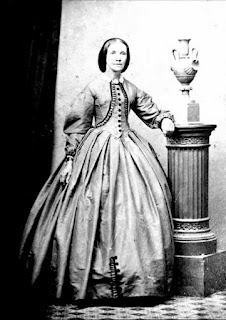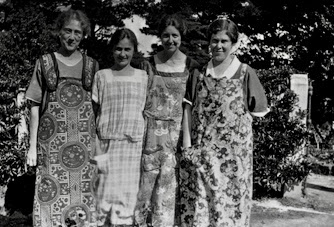6/52: Maps: Annie Eliza Jackson.
6/52 Maps : Annie Eliza Jackson.
Annie Eliza Jackson lived in three different towns in Yorkshire. She was born in Bridlington in the north east, by the sea. As a child her family moved to Hull and then she, her husband and children lived in Sheffield. The main source of my information about Annie and her family is the census, every ten years from 1841 to 1901. In the census you can learn the address, who was living in the house, their ages, where they were born and their occupations. It is possible to build a picture of their lives. Add the google maps and access to historical maps. They begin to come alive.
The pink bit on this map, on the east coast of the UK, is Yorkshire. The bit that sticks out half way down, just under that, lies Bridlington. It is too small to be marked on this map.
This enlarged 1840 map of southern Yorkshire, shows Bridlington,Kingston on Hull and Sheffield
Annie's father was John Jackson and her mother was Frances née Nightingale. Annie was the third of four children with two older brothers and a sister, Mary. They were a Bridlington family going back many generations of both sides, the Jacksons and the Nightingales. They had been sailors but John became a shipwright. Shipwrights often started by doing carpentry on board ship, so John may have begun as a sailor, like his father and brothers, and bettered himself for a land job.
Annie was baptised in 1835 in an Anglican church. By the time she was five they had moved to Kingston on Hull. It is at the bottom of Yorkshire, in the estuary of the Humber. Hull was a one of the big ship building towns along with London, Liverpool, Bristol, and Glasgow. They moved to Sculcoates, on the river. In the years they lived there, the population of Sculcoates exploded from 13,000 in 1831 to 34,000 in 1871. The streets they lived in, Church Street in 1841 and Clarkes Square between 1851 and 1861, are no longer visible in a map of Sculcoates but there is a Bridlington Avenue. So perhaps they came as a community of Bridlingtonians and settled together, as migrant communities often do.
In 1849 a cholera epidemic hit Hull, arriving on ships from Germany and exacerbated by inadequate sanitation and poor drainage in the fast growing city. It reached its peak in September with 24l deaths for every 10,000. For comparison, this week in February, in 2022, COVID deaths in Hull were 2.3 per 100,000 people - which is 1,802 deaths in the last 7 days. John and Frances were later recognised for their caring work during the epidemic. Annie was 14 in 1849 and this would have impacted her. During these years Methodism grew to be the second most popular religion in Hull, after Anglicanism. There were Wesleyan and Primitives and the Jacksons were Wesleyans. It was in his capacity of Town Missionary that he and Frances worked with cholera victims.
He was noted in the 1861 census as a Wesleyan Methodist town missionary. Living with Annie in Clarkes Square, besides her mother and father, was her unmarried aunt, (a milliner), her married sister, Mary, her brother in law, William Craft, (a tea merchant) and their little boy, Charles. Later that year Annie married her cousin, Francis Jackson. They married in St Paul’s Anglican Church on the corner of Bridlington Avenue and Cannon Street, marked on this modern map with a cross. Like Annie he had been born in Bridlington and now, aged 25, like William Craft, he was a dealer in tea, quite a lucrative business in the 1860s..
Sculcoates, today, showing Bridlington Avenue.
Annie and Francis had three girls in Hull: Louisa, (1862) Edith (1867) and Florence, (1870). Then they moved to Sheffield in 1871. It is in the far south of Yorkshire, on the border with Derbyshire. There was a train from Hull to Sheffield.
The 1871 Census has them living in 19 - 21 Nile Street. Today those two story houses are still there and accomodate two different businesses, the Nam Song restaurant and Shooz, a shoe shop.
21 Nile Street, Ecclesall Barlow today.
19 Nile Street, Ecclesall Barlow today.
The two properties housed Francis and Annie, Louisa, Edith, Florence, an assistant grocer, 5 year old nephew Charles and a domestic servant. Perhaps they lived in part of the house and ran the grocer/drapers from the another part. Annie would have been very busy but they were not poor. In October 1871, Emily was born and they had two more children at that address, Gertrude, 1874 and Frank, 1878 when Annie was 42. That’s five girls and a boy, not a large family by the standards of the time. They all survived childhood. And Annie survived pregnancy and birth, right into her forties.
As the children grew up they were trained to help with the business. All of them worked as grocers’ assistants or drapers' assistants. It seems as if the Grocery was run by the males and the drapers was ran by the girls. Edith was sent to boarding school in Derbyshire but when she finished she still worked as a draper’s assistant when she finished school. I do wonder what it was like for a grocer's daughter to attend a boarding school in those times and if she was bullied and humbled by her father's trade connections.
In 1891 the family had moved to Bramall’s Lane, where the big Sheffield Football arena is now. There was a cricket ground in the lane when the Jacksons lived in 413. The house was very full: Francis, Grocer, Annie, and daughters: Edith, Emily and Gertrude, (drapers’ assistants) and son, Frank, a Grocer’s apprentice. Also living in the house was now married Louisa Edlington and her two children aged three and one. Where was her husband, Robert? I can find a Robert Edlington living in London in 1891 but could it be him? Later census’s have them together, he working as a butter and egg salesman. It was a small family business and everyone was involved.
But by 1901 most of them had flown the coop. Francis and Annie still lived in 413 Bramall’s Lane. Emily married a brick layer; Florence married a sea captain and while he was away she lived with her aunty Mary Craft, helping out in their draper’s business. Gertrude was still living at home, drapers assistant. Edith had died in 1900, sadly to suicide. Frank, my grandfather had disappeared off the public record, to return in 1911 in Manchester working as a chauffeur, married to my grandmother.
Curiously my grandmother’s married name was Annie Eliza Jackson, something that tripped me up when I was first trying to build this family tree! That, along side the confusing fact that Annie Eliza Jackson had not changed her family name when she married her cousin Francis Jackson!
There was a test match at the Cricket grounds in 1902 which Australia won by 143 runs. I don’t suppose Annie and Francis imagined that their only son would end up living in Australia, producing another whole line of Australian Jacksons.
Annie died in 1905, aged 69, the same age I am today. She had some sadness to contend with: the death of Edith and the possible falling out with Frank, who surely was expected to take over the business and instead allegedly ran away to be a jockey.
After Annie died, Francis retired and went to live with Louisa.









Comments
Post a Comment